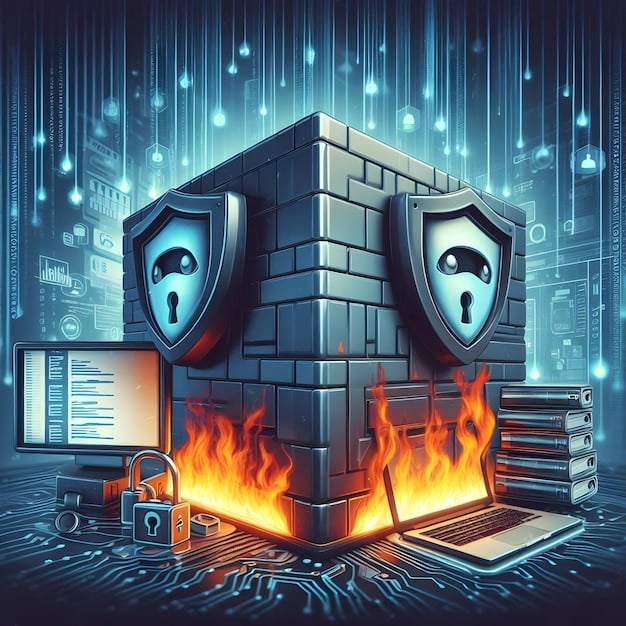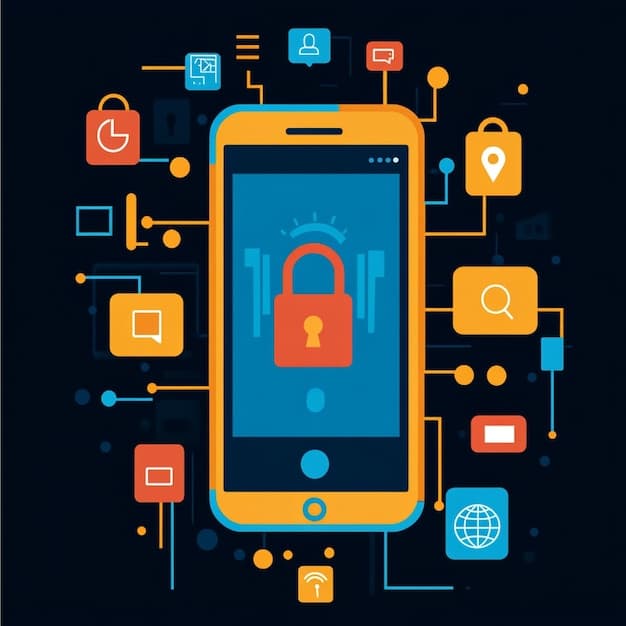Stay Safe Online in the US: Cybersecurity Guide for 2025

Staying safe online in the US in 2025 requires understanding and implementing the latest cybersecurity measures, including strong passwords, multi-factor authentication, recognizing phishing attempts, using VPNs, and keeping software updated to protect against evolving cyber threats.
Navigating the digital world can feel like traversing a minefield if you’re not equipped with the right tools. Our comprehensive guide, “How to Stay Safe Online in the US: A Guide to Cybersecurity in 2025,” is designed to equip you with the knowledge and strategies needed to safeguard your digital life in the United States.
Understanding the Evolving Cybersecurity Landscape in the US
The cybersecurity landscape is constantly evolving, with new threats emerging daily. Understanding these changes is the first step in ensuring your online safety in the US.
The Rising Tide of Cybercrime
Cybercrime is on the rise in the US, affecting individuals and businesses alike. From ransomware attacks to data breaches, the threats are becoming more sophisticated and frequent.
Key Cybersecurity Threats in 2025
In 2025, expect to see a continued increase in phishing attacks, malware infections, and social engineering scams. Staying informed about these specific threats is crucial for protection.
- Phishing attacks continue to be a major threat, targeting individuals through deceptive emails and websites.
- Ransomware is becoming more sophisticated, with attackers demanding larger payouts from victims.
- Data breaches expose sensitive information, leading to identity theft and financial losses.
Staying informed about the evolving cybersecurity landscape is essential for adapting your security measures and protecting yourself from the latest threats. By understanding the risks, you can take proactive steps to mitigate them.

Essential Cybersecurity Practices for Individuals
For individuals, adopting a set of essential cybersecurity practices can significantly reduce the risk of falling victim to online threats. These practices are easy to implement and can have a big impact.
Strong Passwords and Password Management
Using strong, unique passwords for all your online accounts is the foundation of good cybersecurity. A password manager can help you create and store these passwords securely.
Multi-Factor Authentication (MFA)
Enabling multi-factor authentication adds an extra layer of security to your accounts, requiring a second form of verification in addition to your password.
- Use a combination of uppercase and lowercase letters, numbers, and symbols to create strong passwords.
- Enable MFA on all accounts that offer it, including email, social media, and banking.
- Avoid reusing passwords across multiple accounts to prevent a single breach from compromising all your accounts.
By implementing these essential cybersecurity practices, individuals can greatly enhance their online safety and protect themselves from a wide range of threats. These measures are simple, effective, and crucial for staying secure in the digital age.
Protecting Your Devices and Networks
Securing your devices and networks is crucial for maintaining a safe online environment. This involves both software and hardware measures to prevent unauthorized access and protect your data.
Firewalls and Antivirus Software
Install and maintain a firewall and antivirus software on all your devices to protect against malware and unauthorized access.
Virtual Private Networks (VPNs)
Using a VPN encrypts your internet traffic and hides your IP address, providing an extra layer of security when using public Wi-Fi networks.
- Keep your antivirus software up to date to ensure it can detect and remove the latest threats.
- Configure your firewall to block unauthorized access to your network and devices.
- Use a VPN when connecting to public Wi-Fi networks to protect your data from eavesdropping.
By protecting your devices and networks with these measures, you can create a more secure online environment and reduce the risk of cyberattacks. These steps are essential for both personal and professional use.

Staying Safe on Social Media
Social media platforms are a popular target for cybercriminals. Learning how to stay safe on these platforms is essential for protecting your personal information and avoiding scams.
Privacy Settings and Information Sharing
Review and adjust your privacy settings on social media platforms to limit the amount of personal information you share publicly.
Recognizing and Avoiding Scams
Be wary of scams and phishing attempts on social media, such as fake giveaways and suspicious links. Always verify the source before clicking on any links or providing personal information.
- Limit the amount of personal information you share on social media, such as your address and phone number.
- Be cautious of friend requests from strangers and verify their identity before accepting.
- Report any suspicious activity or scams to the social media platform.
By being mindful of your social media activity and taking steps to protect your privacy, you can minimize your risk of falling victim to cybercrime. These precautions are vital for staying safe on these platforms.
Securing Your Financial Information Online
Protecting your financial information online is critical, as this data is a prime target for cybercriminals. Taking proactive steps can safeguard your accounts and prevent fraud.
Secure Online Transactions
Ensure that websites you use for online transactions are secure by looking for the padlock icon in the address bar and checking that the URL starts with “https.”
Monitoring Your Accounts and Credit Reports
Regularly monitor your bank accounts and credit reports for any unauthorized activity. Report any suspicious transactions immediately to your bank or credit card company.
- Use strong, unique passwords for your banking and financial accounts.
- Enable multi-factor authentication for added security.
- Be cautious of phishing emails asking for your financial information and never click on suspicious links.
By implementing these security measures, you can significantly reduce the risk of financial fraud and identity theft. Staying vigilant and proactive is key to protecting your financial information online.
The Future of Cybersecurity in the US
Looking ahead to 2025, the future of cybersecurity in the US promises to bring both new challenges and innovative solutions. Staying informed about these developments is crucial for maintaining a strong security posture.
Emerging Technologies and Threats
Emerging technologies like AI and blockchain will play a significant role in cybersecurity, both as tools for defense and as potential targets for attacks.
Cybersecurity Awareness and Education
Increased cybersecurity awareness and education will be essential for empowering individuals and organizations to protect themselves against cyber threats.
- AI-powered cybersecurity solutions will offer advanced threat detection and response capabilities.
- Collaboration between government, industry, and academia will drive innovation in cybersecurity.
- Continuous learning and adaptation will be crucial for staying ahead of evolving cyber threats.
As we move forward, a proactive and adaptive approach to cybersecurity will be essential for navigating the evolving landscape and protecting against future threats. Staying informed and investing in security measures will be key to maintaining a safe online environment in the US.
| Key Point | Brief Description |
|---|---|
| 🔑 Strong Passwords | Use unique, complex passwords for all accounts. |
| 🛡️ Multi-Factor Authentication | Enable MFA to add an extra layer of security. |
| 🌐 VPN Usage | Use VPNs to encrypt your internet traffic. |
| 🚨 Recognize Phishing | Be cautious of suspicious emails and links. |
FAQ
▼
Cybersecurity is crucial in 2025 due to the increasing sophistication and frequency of cyber threats, which can lead to data breaches, financial losses, and identity theft.
▼
Key threats include phishing attacks, ransomware, malware, and social engineering scams. Staying informed about these threats is essential for protecting yourself and your data.
▼
Use a combination of uppercase and lowercase letters, numbers, and symbols. Avoid using personal information or common words, and aim for a password that is at least 12 characters long.
▼
Two-factor authentication (2FA) requires a second verification method in addition to your password, such as a code sent to your phone or email, to add an extra layer of security to your accounts.
▼
A VPN encrypts your internet traffic and hides your IP address, making it more difficult for cybercriminals to intercept your data or track your online activity, especially on public Wi-Fi networks.
Conclusion
Staying safe online in the US in 2025 requires a proactive and informed approach to cybersecurity. By understanding the evolving threat landscape, implementing essential security practices, and staying vigilant, you can protect yourself and your data from cyber threats and enjoy a safer online experience.






